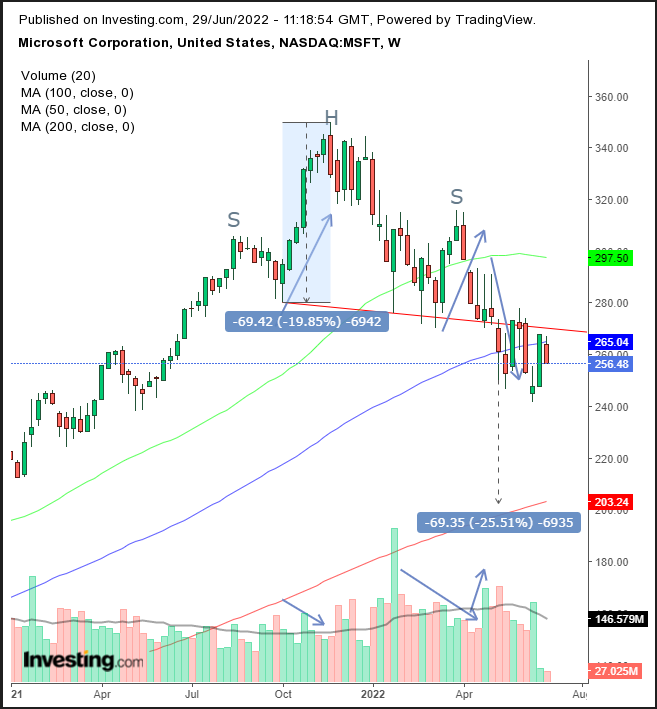After losing more than a quarter of its value since its all-time high on Nov. 22, is it time to buy Microsoft?
Long-term investors could do worse than the world's largest software company by revenue and market cap, which registered record revenue and operating profits in March this year. Microsoft (NASDAQ:MSFT) has also been building its cloud infrastructure division over the last few years and it is paying off. Azure and other cloud services exploded by a mind-boggling 46% in the last year and are expected to increase 20% this year.
This new operation is indicative of the company's ability to use its dominance to move successfully into new areas of growth.
However, the shares have not fared so well. After losing a quarter of their value, MSFT's PE ratio is the lowest since the March 2020 crash.
So, is this an excellent time to buy Microsoft? Some are calling it a bottom. However, we don't think so, even for long-term investors. Based on our technical analysis, MSFT is heading lower still.

The stock completed a sizeable H&S top in early May since August. Note, the divergent volume with the price action, weakening amid rallies and spiking during selloffs. Volume divergence demonstrates that the price is moved by few transactions and will likely not sustain its move. The price attempted to climb back above the neckline—the trendline connecting the range's lows—but failed twice, confirming the Return Move and the pattern's integrity.
The price failed to remain above the 50-week MA, gapping below, amid the development of the right shoulder. This week, the price fell back below the 100 WMA.
The 200 WMA, is at $203, suggesting another 20% potential loss. On top of that, the pattern's implied minimum target —its height—is at the same price level. Funny how the puzzle pieces fit together.
Trading Strategies
Conservative traders should wait for the price to register a new low, below the June 14 price, before risking a short position.
Moderate traders could wait for the price to retest the June 27 high to limit exposure before committing to a short.
Aggressive traders can short now, provided they can absorb whipsaws. Money management is crucial. Here is a generic example:
Trade Sample - Aggressive Short Position:
- Entry: $260
- Stop-Loss: $270
- Risk: $10
- Target: $210
- Reward: $50
- Risk-Reward Ratio: 1:5
Author's Note: The trade sample is just that, and it does not suggest that there are no other ways to approach this trade. The model is not an analysis. That is in the body of the post. We recommend you read and understand it before risking your money. The study is based on our interpretations of the supply and demand for MSFT. Even if we are right about the analysis, this sample may not pan out. We are not in the business of fortune-telling. Trading is nothing more than "luck management," as traders attempt to survive losing trade to get to winning trade and catch up with statistics, which by definition work overall, not on any particular transactions. Happy trading!
